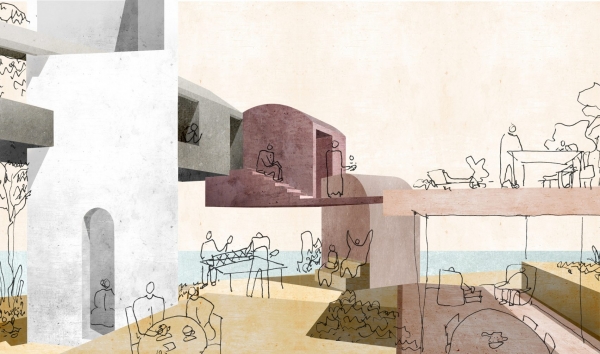Architects like Tatiana Bilbao are proving that collage is more than an aesthetic — it is a way to open up the design process.
Collage has become one of the most powerful narrative techniques in architectural drawing. The wide-ranging medium mixes references and connections to culture, context and place. As an architectural tool, collage has been used both to imagine surreal spaces and as a conceptual element of planning. But it is more than an aesthetic — it is also a way to create a more collaborative and inclusive design process.
Collage comes from the Greek word kolla meaning “glue.” As representation is its own type of project, collages are used to convey multi-layered atmospheres through drawing. Like glue, they bring fragments of images, sketches, patterns, materials and textures together. In turn, they define architectural and spatial concepts. Collages can be used for generating new ideas, to represent projects, or as part of the design method and process itself. The central idea is defined as a work of representation made with various different materials combined or collected together. Integrating visual and physical elements, the result is usually a quicker and more iterative way to explore and translate ideas.
One of the greatest aspects of collage is that each approach is unique, tied to the individual and their method and style for creating the image. As MoMA outlined during its Cut ’n’ Paste show curated by Pedro Gadanho and Phoebe Springstubb back in 2013, the ethos of collage shapes “every aspect of contemporary culture, from the glut of signs and images to the many layers of digital information to the art of sampling.” The exhibition revisited early uses of collage to trace its evolution as both an aesthetic technique central to architectural representation and a cultural practice of layering, juxtaposition, and remix that configures the city. In turn, it showcased a wide range of styles and emerging techniques over time.
Using collage as a photomontage can also be a method to subvert image making and render the invisible visible. Architectural researcher, designer and performer Khensani de Klrek of Matri-Archi has explored these ideas through intersectionality and representation in research and practice. She outlines the potential of eidetic photomontage, where photographic images are “characterized by compositional cues that create links – even if subtle – to realities, stories and histories. These types of collages can be created physically or digitally, and tend to rely on resituating photographic images into new settings with intentions to provoke critical discourse, rather than simply display the idea or environment.” Eidetic photomontage explores the potential of collage-making to resist, subvert and dissolve controlling images.
For professional architectural visualizer , quick ideation can involve generating a collage style illustration. As he notes, these types of illustrations are great for speed but also for informal presentations where broad ideas and atmosphere are the focus (as opposed to an emphasis on minute detail).
“Post processing is typically much looser and maintaining proper perspective is unnecessary. Instead, compositions are more playful and there are almost no rules. For this image, I saw it as a way to flesh out some ideas that I had about landscape and building materials.” As he explains, this quick study makes the point that you can convey ideas through fast imagery without complicated models or rendering engines.
Mexican architect Tatiana Bilbao notably reimagined representation in her studio through collage. She chooses not to make any computer visualizations of her designs that are still a work in progress. Instead, collages are used to develop new building ideas. She regularly notes that she sees her architecture work as a platform where everyone can add their complexities, diversities and personalities. Collage becomes a tool to express ideas in a collaborative way.
Bilbao explains that, “We use collage not only to conceive our work, as a method of design, but also to represent it. For example, we have done projects in which we design with references, with images, with photos of other things with spaces we want to create, and then we collage them, show them to the client, and then we design on top of that. It’s a method of integrating, physically and visually, all those references that we always have into the design while expressing our ideas easily. You are able to recognize what we are thinking because you recognize the [reference] space we are showing you.” For her, collages allow for processes and room for mistakes, making space for exploration and interpretation.
Whether used for explaining ideas to clients and colleagues, or for generating ideas, collages make the most of mixed media to combine fragments and create new meaning. These compilations of contextual elements can form new visions of the future. When generating new ideas, representing projects, or exploring a design process, collages open up possibilities. In a sense, they are a type of drawing that is endless and never really finished, allowing room for multiple readings. In turn, they open architecture and design to new ideas.
—
**Source: https://architizer.com/blog/practice/details/rethinking-architectural-collage/
**Author: Eric Baldwin
**Image Credit: Duong Vu Hong / Fala Atelier / Khensani de Klerk / Alex Hogrefe / Tatiana Bilbao / Tatiana Bilbao Estudio


